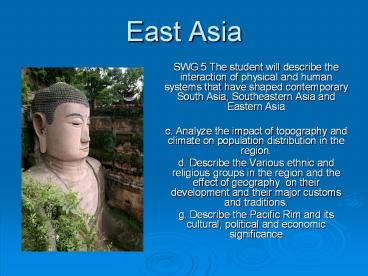East Asia - PowerPoint PPT Presentation
Title:
East Asia
Description:
East Asia SWG 5 The student will describe the interaction of physical and human systems that have shaped contemporary South Asia, Southeastern Asia and Eastern Asia – PowerPoint PPT presentation
Number of Views:118
Avg rating:3.0/5.0
Title: East Asia
1
East Asia
- SWG 5 The student will describe the interaction
of physical and human systems that have shaped
contemporary South Asia, Southeastern Asia and
Eastern Asia - c. Analyze the impact of topography and climate
on population distribution in the region. - d. Describe the Various ethnic and religious
groups in the region and the effect of geography
on their development and their major customs and
traditions. - g. Describe the Pacific Rim and its cultural,
political and economic significance
2
China
3
Early Civilization
- China was ruled by powerful families called
dynasties. The head of the dynasty was called the
emperor. - China has a history of invasions. In 215 B.C.,
the Great Wall was built (1500 miles) for
protection, but did not work
4
(No Transcript)
5
Europeans Arrive
- China is isolated until Europeans, like Marco
Polo, arrive in 1200s - In 1800s, European powers seek access to Chinese
markets - Treaties force weak China to give Europeans
privileges - The Chinese resist European influence in the
Boxer Rebellion (1900)
6
(No Transcript)
7
Communist Revolution
- Nationalist Party took over the government in
1912, making the country a republic (Chiang
Kai-shek) - 1920s-1930s the Communist Party grows in power
(Mao Zedong) - Civil War between the Nationalists and Communists
until the Communists win in 1949 - In 1949 the Communists set up the Peoples
Republic of China - The nationalists fled to the island of Taiwan
creating the Republic of China
8
Economy
- China is largely rural society, agriculturally
self-sufficient - Only 13 of land is suitable for farming
- During communism, industrial growth stunted
- 1980s markets open and economy grows
9
Population Patterns
- One-fifth of worlds people live in China
- population is about 1.3 billion
- 70 of people live in 12 eastern provinces
- in west, 6 of nations people live on 55 of its
land
10
Mongolia
11
Government
- Mongols are nomadic herders until Genghis Khan
conquers Central Asia - Mongolia becomes Communist in 1924
- remains Communist until 1989 fall of USSR
- Mongolia now moving toward democracy
12
Economy
- Many herd, manage livestock (sheep, goats,
camels, horses, cattle) - Developing industries while making difficult
shift to market economy - Soviets guided economy for 70 years, state owned
factories
13
(No Transcript)
14
Taiwan
15
History and Culture
- Japanese take Taiwan (Formosa) in 1895 after
victory over China - Chinese Nationalists lose to Communists, flee to
island in 1949 - establish Republic of China not recognized by
China - Population and culture is almost exclusively
Chinese - Most speak official language of Northern Chinese
(Mandarin)
16
North and South Korea
17
History
- China and Japan conquer Korea throughout history
- Japan conquers Korea in 1910, rules until WWII
defeat in 1945 - After WWII
- NK controlled by USSR
- SK controlled by U.S.
- In 1950, NK troops invade SK, begin Korean War
- 1953 treaty ends war, divides peninsula
- NK is Communist state, SK is democracy
- two nations remain hostile
- reunification discussions have begun
18
Culture
- Korea adopts many philosophical, religious ideas
from China - Confucian, Buddhist influences
- Both North and South Korea build huge armies
after WWII - Danger of war always looms2 million troops on
both sides of border
19
(No Transcript)
20
Japan
- Japan is the economic giant of East Asia
21
Ancient Japan
- Ruled by clans
- In 1192, after a clan struggle, emperor creates
shogun position - shogungeneral of emperors army with military
dictator powers - controls officials, judges, armies picks
governors
22
World Power
- By the early 20th century, Japan is a major power
- Expanding empire puts Japans interests in
conflict with U.S - U.S. occupies Japan brings political, economic
reforms - Japan becomes democracy
- constitutional monarchy with emperor and elected
parliament
23
Economy
- Post-war economic boom makes Japans economy
second in size to U.S - 75 live in cities 60 live on 2.7 of land
- Japan imports resources to manufacture products
for export - exports autos, electronics, computers
24
(No Transcript)
25
Western Influences
- Popular sports are baseball, golf, sumo
wrestling, soccer, tennis - Most clothes are Western traditional clothes for
special occasions - Western music is popular, including rock,
classical, jazz - younger Japanese form rock bands
- Japan balances its own traditional styles with
Western influences
26
Education
- Highly structured educational system
- students in school six days a week six weeks of
summer vacation - six years of elementary, three of junior high,
three of high school - Japan has more than 1,000 universities and
technical schools
27
(No Transcript)































